‘Neither very good nor very bad’: The Dunmanway workhouse, County Cork 1841-1920
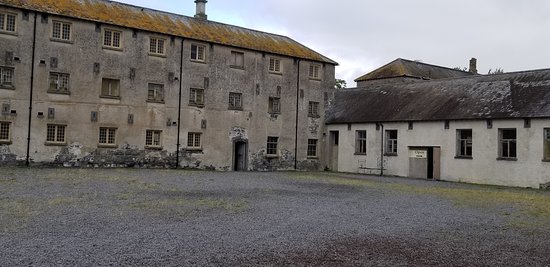
By John Dorney
The workhouse was the last recourse of the poor in nineteenth century Ireland. In return for work, those otherwise without support were given food and board. Ominously, they were referred to as ‘inmates’ the same language used to describe prisoners.
While some cities such as Dublin, Cork Belfast and Limerick had workhouses in the 18th century, it was an investigation undertaken by the British government in the 1830s, which testified to the widespread poverty in rural Ireland and began the construction of a network of rural workhouses. The population doubled between about 1800 and 1840 from about 4 million to over 8 million and most of the increase was in poor rural areas with little industry and few prospects for employment.
Workhouses were constructed throughout rural Ireland in the late 1830s.
As a result, starting in 1839, over 130 workhouses or Poor Law Unions, were built around the country, sturdy but grey fortress like stone structures, to house ‘sturdy beggars, ‘disorderly women’, foundling children’ and to ‘punish vagabonds’. [1]
The workhouse was supported by the rate payers of the poor law district, who elected The Poor Law Guardians to oversee how their money was spent. It was they, the local tax payers, who selected the ‘Master’ and ‘Mistress’ of the workhouse, who oversaw the administration of the Poor Law Union, though they also needed the approval for appointments of the Poor Law Commissioner, who was a civil servant appointed by the British administration in Ireland in Dublin Castle.
Workhouses came to be seen as fearful places, sites of infection and death by the rural poor. However, while during their first decade, which coincided with the Great Famine, this was quite justified, most workhouses were dreary rather than desperate places by the late 19th century. This article will try to show what life was like in one such workhouse, in Dunmanway in West Cork.
Famine
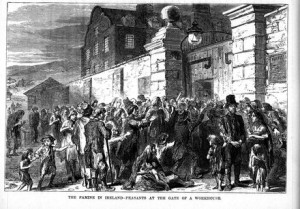
Dunmanway Poor Law Union was created in 1839 and the workhouse itself constructed in 1841, just before the Great Famine.
At first the workhouses were very unpopular with the rural poor. As well as the shame of attending one, they also stripped the poor of their dignity by enforcing segregation of the sexes, confinement, physical labour, poor food and an inadequate diet. Before the famine, most rural workhouses were virtually empty.[2]
However, only a few years after it opened in 1841, Dunmanway workhouse was hit by the worst social crisis in 19th century Irish history, the Great Famine of 1845 to 1851.
During the famine, the workhouse, built in 1841 for about 400 inmates, held 866 people and by March 1847 inmates were dying there at a rate of 70 a week.
During the famine, the workhouse, built in 1841 for about 400 inmates, held 866 people – or was packed to over twice its capacity. Some had to be housed in stable sheds and a fever hospital was hurriedly erected. By March 1847, inmates were dying there at a rate of 70 a week, one of the dead being the workhouse’s schoolmistress.[3]
But even this horrific death toll was low compared with elsewhere in Cork, for example at Skibbereen, where the death toll was much greater. According to some accounts, Dunmanway workhouse was relatively benign because the local landlord, William O’Neill Daunt, unlike many other landlords, did not try to evade paying for poor relief during the Famine. [4]
However, a report by the poor law commissioner in 1847 said of Dunmanway Poor Law Union that it could ‘hardly have been more dirty or disorderly’… the ‘sewers in the yard are not swept, ventilation is not attended to the smell throughout the house is most offensive.’ The ‘niggardly guardians’ refused to give milk and white bread to dysentery patients’.
Such was the impact of the ‘Great Hunger’ that the population of the Dunmanway area fell from 31,000 in 1841 to 21,000 in 1851, and continued to fall thereafter.[5]
The famine lasted at least five years, though its severity varied from district to district. One of the longer lasting effects of the calamity was that through death and also massive emigration that followed the famine, much of the poor rural population disappeared in the decades afterwards.
Thereafter the workhouse at Dunmanway, while never a pleasant place to end up, was no longer a pace of mass death and suffering as it had been in the famine years.
Appointments
Because the appointment of staff was in the hands of a local elected body, the Poor Law Guardians, there was a lot of local politics involved in appointments. The Master and Mistress of the workhouse were appointed by the Guardians – the main local rate payers and had to be approved by a majority vote of the Guardians.
Appointments in the workhouse were subject to local politics. The 1872 election of a new Master at Dunmanway was particularly messy.
The 1872 appointment of a new Master for the union was particularly messy. There seems to have been competition between two prominent local landlord families, the Meades and Unkles, who at the time would have been the largest tax payers in the locality.
James Regan, the previous master, resigned but agreed to stay on in a caretaker capacity until a new Master was appointed.
However on 17 May 1872, the poor Law Guardians received a letter from 23rd District Poor Law Commissioner P. Larr refusing to sanction their appointment of Thomas Kearney as Master of Workhouse 21 May, 1872 and his wife as matron. It is not clear why he did this, but he must have been concerned about something in the hiring process. Perhaps the post had not been properly advertised.
The clerk was then directed to advertise in Dublin General Advertiser and four Cork papers for position of Master at £30 per annum. Election to take place 11 June 12 noon. An interesting thing about this is that James Regan, the previous Master was paid at £40 per annum (though he seems to have held the post of Master and Clerk), so the new Master was taking a significant pay reduction compared to his predecessor. [6]
Initially there were two candidates for Master, after Thomas Kearney was rejected; Michael Sullivan and Dennis Lyons. Sullivan was elected by 10 votes to 9, and promised to start on 24 June. [7] However, Sullivan disappointed them. On 2 July Larr, the Poor Law Commissioner, sought copies of Michael Sullivan’s testimonials, ‘on account of his resigning the position of master four days after being elected’. [8] Basically the Poor Law Guardians had been outbid for Sullivan’s services. Sullivan wrote to the Guardians, ‘the lady for whom I am doing business has secured my services on such terms that in justice to my family I could not refuse’. And so the clerk was directed to advertise the post again at £30 per annum to start on 23 July. [9]
This time there were two candidates, Timothy Burke and Dennis Lyons, for master. Burke was proposed by William Meade seconded by Shouldham, the chair of the Board of Guardians, Lyons by Unkles and O’Sullivan. The election was declared void at 8 votes each and the Guardians resolved to have a new vote Aug 6. And for the post to be advertised again. [10]
The fourth and as it turned final, attempt to elect a master took place at the vote on August 6, 1872. This time there were three candidates; Dennis Lyons, Tim Burke and Florence Crowley. Cowley (who later also appears as chair of the Board of Guardians) was eliminated on the first count. The final vote was between Burke and Lyons. Burke won, 9-7 and was directed to spend time learning the job from the acting master Regan until he took over properly. [11]
Tim Burke was keen to start but in his second master’s report was slightly upbraided by the Board for reporting the bread as ‘good when it tasted ‘sour’.
It is difficult, from the sources we have, to get the bottom of whatever local politics lay behind all this manoeuvring. But one constant is that the local Poor Law Union was short of money. P. Larr, the Commissioner, complains that many rates that had not been collected and sends a list of defaulting rate payers. William Meade and another long time member of the Board, Daniel Comer also complained about a discrepancy between the white bread and tea ordered and the amount in the store. Situation had been going on for five years. All of which suggests a hint of corruption in the workhouse management. [12]
Tim Burke and his wife held the position of Master and Mistress of the workhouse from 1872 until 1920.
Daily life in the workhouse
To gain admittance into the workhouse, a person had to be destitute. If they were not, their money was taken from them to pay for their upkeep when they entered, which is a fairly common occurrence in the minutes. For example in February 1895, a woman named Mary Murphy was admitted with £9 in her possession, which was ‘handed to the master’. [13]
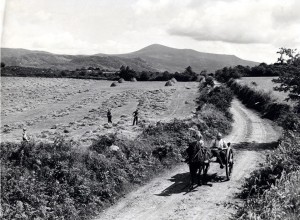
One noticeable feature of the workhouse, during Tim Burke’s long career as Master there, was the declining numbers of inmates. Perhaps because of the declining population in the Dunmanway area, the numbers in the workhouse fell continuously. In 1871 there were 136 inmates, in 1895, 91, and in 1920 when the workhouse was closed after it was seized by the British military, there were only 50 inmates.
A representative report is that of 1871, which lists the total in workhouse at 136. Males 111, Females 22. There were 44 ‘infirm and aged’ and 25 children. The net value of the workhouse funds was £32,919.[14]
Able-bodied inmates were required to work, bringing in hay, planting or picking potatoes or other work connected with the upkeep of the workhouse.
Able-bodied inmates were required to work, bringing in hay, planting or picking potatoes or other work connected with the upkeep of the workhouse.
Every week Tim Burke, as Master, had to make a Master’s report. Invariably, this listed how many times the children of the workhouse were taken out for exercise (usually three or four times). Sometimes it also included a report on children’s schooling – the workhouse permanently employed a school mistress. Life for the children was only enlivened by the odd charitable donation for instance, in 1895, Jan 26, Burke reports that Miss Connor of March House visited the Union and presented the children with fruit and toys.[15]
The Master’s report also typically listed any work that needed to be done and any outsider tradesmen who needed to be hired.
It also detailed any purchases. Tim Burke was in the job for a long time and seems to have driven a hard bargain with contractors. For example, his report of January 1895 stated that ‘quantities of flannel etc. ordered were not equal to that supplied by contractor’. The goods were to be returned and if it happened again, the master would buy the extra needed on open market at contractor’s expense.
Tim Burke’s wife, the matron was required to keep the workhouse clean and also perform other tasks. In 1895 the Matron complained about having to cut and make women’s clothes when there were able bodied women in workhouse. Tim Burke wrote ‘It is quite enough for her to superintend same. She has great difficulty in getting washing and cleaning done’.[16]
The workhouse was a grim enough place. Patients were often sick, and sometimes died. Medical reports often detail outbreaks of smallpox and measles, both of which were potentially deadly. On two occasions in the minute books inspected, there were cases of attempted suicide. In 1906 [17] a 70 year old woman attempted suicide by cutting. And in 1915, on 6 June, an inmate was prevented from committing suicide with a pocket knife.[18]
The 1895 British Medical Journal Report
In 1895 a deputation of doctors from the British medical journal visited the workhouse and were scathing about the conditions there.
They complained of a ‘general air of neglect’. Their report described the nursing arrangements at Dunmanway as “a travesty” and the wards as “quite unsuitable” for their purpose. They also pleaded for some basic comforts for the aged, armchairs, better heating and lighting in the wards, and improved sanitary facilities — there were no indoor toilets, just “soil pails” which left uncovered and unemptied during the night.
An 1895 report complained of a ‘general air of neglect’ and described the nursing arrangements at Dunmanway as “a travesty” and the wards as “quite unsuitable” for their purpose.
Though, in some defence of the Burkes, they noted that ‘There was a touch of humanity about the administration which we were pleased to note; the defects are those of an evil system more than of those who work it.’
There seems to have been a rather mild reaction in the minute books to the medical visit. The Poor Law Guardians as rate payers, were motivated at all times, not so much to keep up the standards of care at the workhouse, as to keep the costs down.
The Poor Law Guardians simply directed Tim Burke to make some specific repairs and improvements. On p. 347 of 1895 minutes the Board enclose details of Medical Inspector [Browne’s] report, especially regarding ‘Sanitary Conditions’ of Dunmanway workhouse, and requested that it and several other matters ‘receive attention’. Later the Board requested that per Dr Browne’s report, a midwife be appointed and ‘dispensary defects be attended to’ and call for the Master to connect the different sewers and ensure they are flushed.[19] They also called for work to be done on water supply, fixing pipes to ensure less water was wasted.[20] They seem to have left it at that.
The next medical report on 10 Jan 1901, by ‘Colonel Turkwood’ reported that the workhouse was ‘Satisfactory’ regarding management and the condition of workhouse. Its only complaint was that the (horse drawn) ambulance was old fashioned and they needed a four wheeled vehicle. It also recommended that unoccupied wards be used for consumption patients.[21]
Discipline in the workhouse
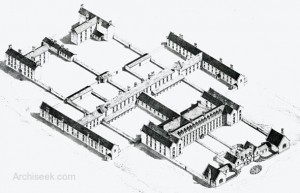
Tim Burke seems to have been a tough Master but not particularly unkind or cruel. For instance, in May 1895 he requested care for an ‘imbecile’ (or intellectually disabled) inmate, as the ‘other men will not care for him’. Burke recommended a space in the hospital for him.[22]
However, he brooked no ill discipline. In January 1895 for instance, the Schoolmistress complained that inmate Mrs Ellen Collins was cursing her. Ellen Collins was brought before the Board, and warned if it happened again, she would be prosecuted.[23]
And on other occasion Tim Burke followed through on this threat. In 1907, a local newspaper report details Burke giving evidence in Cork about three women, ‘insubordinate inmates’, particularly one Maria Lynch, who came in drunk, ‘disturbed supper’ and called Mrs Burke ‘filthy names’ and that other inmates Rose Lynch and Ellen Stack also ‘gave her bad talk’.
‘Insubordinate inmates’ were sometimes prosecuted.
In the workhouse minute book Tim Burke gave an update on the ‘insubordinate inmates’, Maria Lynch received seven days in Cork Gaol as punishment. Her daughter Rose Lynch and Ellen Stack were let off with a caution by magistrate. The Lynch family were sent away from the workhouse.
After, however, they applied for work at the Union again. Burke was firm; ‘If discipline is to be maintained in the House, this class of woman ought not to be employed, especially as we have plenty of women at present to do the work.’[24]
Tim Burke appeared in the local papers at a hearing of the Dunmanway Poor Law Guardians in 1915, accused of exploiting inmates. In September 1915 the Skibbereen Eagle reported at length about a hearing of the Poor Law Guardians in which in inmate Tim Lehane alleged that Tim Burke and other members of staff at the workhouse were employing inmates as cheap labour on their farms. Lehane’s complaint was investigated by the District Inspector Mr Delaney.[25]
The controversy appears to stem from an incident in May 1915 when Burke reported in his Master Report that ‘Inmate Tim Lehane refuses to do any work as says he has a sore finger and gets saucy when spoken to’.[26]
This row seems to have led to Lehane’s complaint and ultimately to the hearing. The Board heard in June of the letter of complaint from Inspector P Delaney to Board regarding Lehane’s preferring charges against the Clerk, Master and porter. They resolved to take statements from all concerned, but in the end no action was taken. [27]
1920: The British military close the workhouse
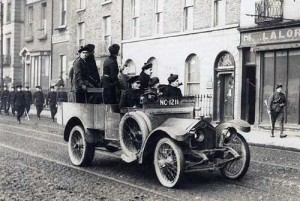
In 1920, dramatic events throughout Ireland caught up with the workhouse at Dunmanway.
In 1918 Sinn Fein won the General Election in December of that year and in January 1919, declared an Irish Republic and its parliament the Dail. The British declared the Dail to be an illegal assembly and an armed confrontation gradually developed between the forces of the Crown the Republican guerrillas of the IRA.
In March 1920 Sinn Fein also won the local elections across Ireland, controlling most County Councils, Corporations and local Government boards. It is interesting to note that while, back in the 1870s, when Tim Burke was appointed as Master, the board of the Poor Law Guardians at Dunmanway had been dominated by landlords of Anglo-Irish and mostly Protestant background, this was no longer true by 1920. By then, most of the Poor Law Guardians seem to have been nationalist in sympathy, perhaps as a result of the changing fortunes of land owners owing to the Land Acts, by which tenants could buy out their holdings and the democratisation of local government with the extension of the franchise since 1898.
At any rate, in March 1920 the Poor Law Guardians in Dunmanway pledged allegiance to the Dail and the Irish Republic. They resolved, ‘that we pledge our allegiance to the Dail Eireann and that we abide by the decrees of that body’.[28]
In May 1920 the British military commandeered the workhouse as a barracks and it was garrisoned by a company of Auxiliaries from December 1920 until early 1922.
In May 1920 the British military commandeered the workhouse as a barracks, but it continued to operate until December 1920 when it was garrisoned by a company of the Auxiliaries – the corps of paramilitary police that had been drafted into the Royal Irish Constabulary.
Records by this point become very patchy and many pages in the minute books are left blank. Rising nationalism clearly affected the Poor Law Guardians as they resolved in late 1920 to conduct all future business in Irish and to teach Irish dancing to the children in the workhouse.
The last entry says that ‘owing to presence of military’, it was necessary to ‘adjourn future meetings’ as the Guardians have difficulty in attending. In December 1920 the workhouse was commandeered for use of the Auxiliary Division RIC K Company. The Burkes were forced into retirement and the remaining fever patients were transferred to Bandon. [29]
The Auxiliaries of K Company, who occupied Dunmanway workhouse from December 1920 until January 1921, were a particularly brutal unit. On December 11, 1920, in response for an IRA ambush in Cork city in which one of their men was killed, they burned out the centre of Cork city including the city Hall and the Carnegie Library.
When stationed in Dunmanway, one of the first things they did was to shoot a local priest Canon Magner and a youth Tim Crowley. The officer responsible – Hart, was declared guilty but insane. The resident magistrate who looked into the case was kidnapped by Hart’s comrades. Other Auxiliaries in Dunmanway robbed the bank there. K Company was disbanded in March 1921, but replaced in Dunmanway by another Auxiliary unit.[30]
The end of the workhouse at Dunmanway
The Auxiliaries in Dunmanway abandoned the workhouse under the Treaty in January 1922. The workhouse was burned by the local IRA in the summer of 1922 during the Irish Civil War to deny it as a garrison to Free State troops.[31] The remaining building was designated as a District Fever Hospital and today is part of St Anthony’s local hospital.[32]
Under the Irish Free State, workhouses were abolished altogether by the Local Government act of 1923 and replaced with District Hospitals and County Homes. In many cases such changes were cosmetic, but it was viewed as symbolic removal what was widely considered to be a relic of an oppressive nineteenth century social system.
The workhouse was burned by the IRA in 1922. Today a local hospital stands on its site.
As we have seen in the case of Dunmanway, the thinning out of the rural population by emigration and the improved economic prospects of the remaining farmers meant that there was no longer a large destitute rural population. Poverty and destitution were now more likely to be found in urban rather than rural areas.
One local, writing in 1971, remembered the Dunmanway workhouse as ‘no better and no worse than any other in Ireland, then or for half a century before. A sombre ill-planned rambling structure, it was neither very good nor very bad’.[33]
The new state found other methods of dealing with the poor and with unmarried mothers and their children, not always any more humane than the workhouses that had preceded them. But the Poor Law Unions themselves, popularly associated with shameful poverty and with the horrors of the famine, were history.
References
[1] Peter Higginbotham, the Workhouse in Ireland http://www.workhouses.org.uk/Ireland/
[2] Cormac O Grada, Black 47, The Great Irish Famine, p.50-52
[3] Peter Higginbotham, Dunmanway Workhouse, http://www.workhouses.org.uk/Dunmanway/
[4] Liam O’Brien, Reflections on Dunmanway Union and its Workhouse during the Great Famine, http://www.undergraduatelibrary.org/system/files/UG%20Awards%20reflections.pdf
[5] James S Donnelly, The Land and People of 19th century Cork, pp. 95-96, p.129)
[6] Dunmanway Poor Law Union Minute Book 1872, p.490, Cork city Archives
[7] Ibid. P. 550.
[8]Ibid. p.607
[9] Ibid. P.610
[10] Ibid. P.670
[11] Ibid. P710
[12] Ibid. p.630
[13] Dunmanway Poor Law Union 1895 minute book p.97, Cork City Archives.
[14] Dunmanway Poor Law Union Annual report 1871, Cork City Archives
[15] Dunmanway Poor Law Union minute book 1895 p.67, Cork City Archives
[16] Ibid. P.367
[17] Dunmanway Poor Law Union minute book 1906, p.528
[18] Dunmanway Poor Law Union Minute Book 1915, P.683
[19] 1895 Minute Book (P.377)
[20] Ibid. p.407
[21] Dunmanway Poor Law Union annual report 1901, Cork City Archives
[22] Dunmanway Poor Law Union Minute Book 1895, p.337,
[23] Ibid. p.67
[24] Dunmanway Poor Law Union Minute Book 1907, p.339
[25] Skibbereen Eagle, September 1915
[26] Dunmanway Poor Law Union Minute Book 1915 p.543
[27] Ibid. P.629
[28] Dunmanway Poor Law Union Minute Book 1920 p.543
[29] Dunmanway Poor Law Union Minute Book December 1920
[30] The Auxiliaries website http://theauxiliaries.com/companies/k-coy/k-coy.html
[31] Southern Star, 23/10/1971 The Black and Tan Diary
[32] Peter Higginbotham, Dunmanway Workhouse, http://www.workhouses.org.uk/Dunmanway/
[33] Southern Star, 23/10/1971 The Black and Tan Diary